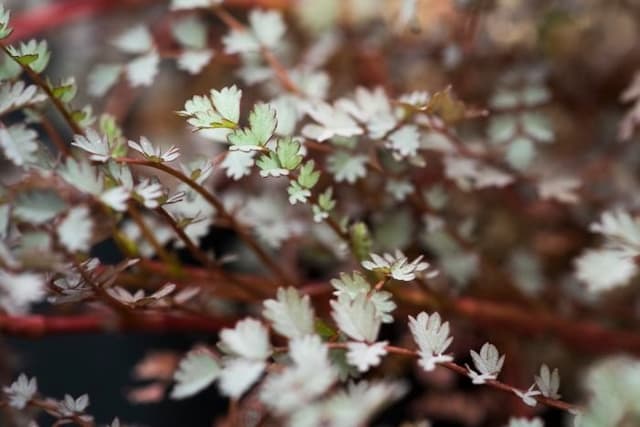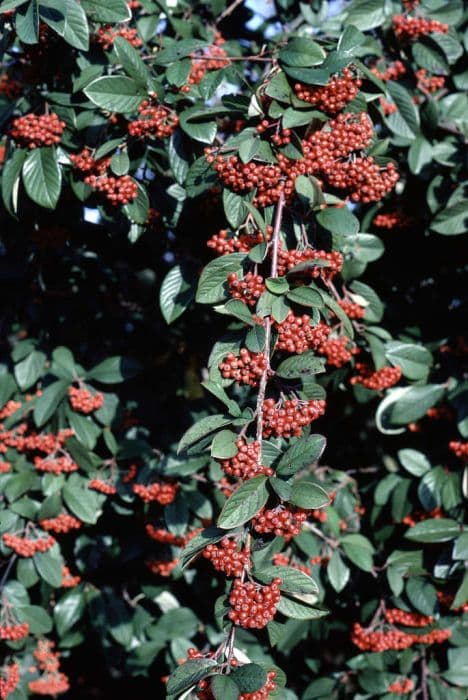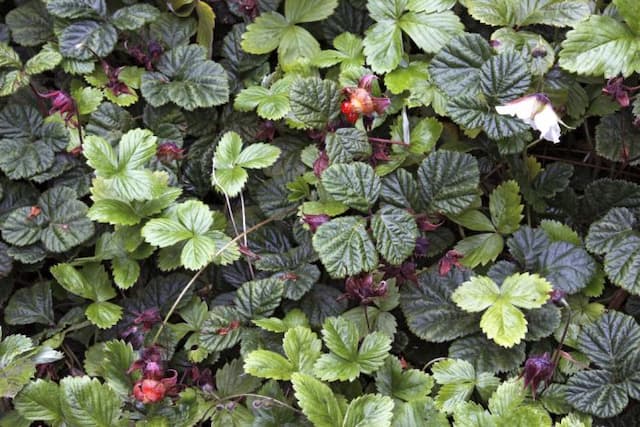Japanese quince 'Orange Beauty' Chaenomeles japonica 'Orange Beauty'

ABOUT
'Orange Beauty' is a spreading, thorny shrub with rounded, glossy leaves, red-flushed when young. Clusters of red-orange, cup-shaped flowers are produced in spring, followed by yellow, scented fruit
About this plant
 Names
NamesFamily
Rosaceae
Synonyms
Japanese Quince, Maule's Quince, Dwarf Quince
Common names
Chaenomeles maulei, Cydonia japonica, Cydonia maulei.
 Characteristics
CharacteristicsLife cycle
Perennials
Foliage type
Deciduous
Color of leaves
Green
Flower color
Orange
Height
3 feet (0.91 meters)
Spread
5 feet (1.52 meters)
Plant type
Shrub
Hardiness zones
5
Native area
Japan
Benefits
 General Benefits
General Benefits- Ornamental Appeal: Japanese Quince 'Orange Beauty' displays vibrant orange-red blossoms that add striking color and aesthetic appeal to gardens and landscapes.
- Attracts Pollinators: Its flowers provide nectar and attract a variety of pollinators, including bees and butterflies, which are beneficial for the environment.
- Drought Tolerance: Once established, Japanese Quince 'Orange Beauty' is quite drought-tolerant, requiring minimal watering and reducing the need for irrigation.
- Low Maintenance: It is known for being low maintenance, requiring only minimal pruning to maintain its shape and remove any dead or crossed branches.
- Adaptability: This plant can adapt to a range of soil types and conditions, from acidic to alkaline and from heavy clay to sandy soils.
- Cold Hardy: Japanese Quince 'Orange Beauty' is cold hardy and can withstand freezing temperatures, making it suitable for growth in many climates.
- Long Blooming Period: It has a long blooming period from late winter to early spring, providing color in the garden when many other plants are still dormant.
- Wildlife Habitat: The dense growth habit of the shrub provides shelter and habitat for birds and small wildlife.
- Erosion Control: Japanese Quince 'Orange Beauty' can be used on slopes and banks for erosion control thanks to its robust root system.
- Versatility in Landscaping: It can be used for a variety of landscaping purposes, including as a specimen plant, in mixed borders, or as hedging and screening.
- Seasonal Interest: With its attractive flowers and later fruit, Japanese Quince 'Orange Beauty' adds seasonal interest to gardens throughout the year.
 Medical Properties
Medical Properties- Anti-inflammatory: Chaenomeles japonica 'Orange Beauty,' also known as Japanese quince, may have components that help reduce inflammation in the body.
- Antioxidant: The fruit of the Japanese quince is known to contain high levels of antioxidants which can help in protecting the body from oxidative stress.
- Antiviral: Some studies suggest that extracts from the Japanese quince might possess antiviral properties, potentially helpful in fighting certain viruses.
- Antibacterial: The plant has been found to contain substances with antibacterial effects that could help in preventing or treating bacterial infections.
- Immune system support: Japanese quince might contain nutrients or compounds that can help in boosting the immune system’s function.
- Anti-allergy: There is some evidence that the plant could have anti-allergenic effects, helping to ease allergic reactions.
- Anti-diarrheal: The fruit of the Japanese quince has traditionally been used in some cultures to help manage diarrhea.
- Regulating digestion: Extracts from the plant may help in improving digestion and alleviating various digestive disorders.
 Air-purifying Qualities
Air-purifying QualitiesThis plant is not specifically known for air purifying qualities.
 Other Uses
Other Uses- Japanese Quince 'Orange Beauty' fruit is used to make bonsai trees, giving a miniature landscape aesthetic with its attractive spring flowers and colorful autumn fruits.
- The dense, spiny branches can be employed as a natural barrier or hedge, deterring unwanted wildlife and intruders.
- The plant's flowers can be used for ornamental purposes in flower arrangements, adding a bright splash of color.
- Branches of Japanese Quince 'Orange Beauty' may be forced in the winter, bringing early spring blooms indoors for decoration.
- Japanese Quince 'Orange Beauty' can be trained against a wall or fence in an espalier form, creating an artistic garden feature.
- The woody stems of mature shrubs can be carved into small decorative items or used in woodworking projects.
- Dried slices of the fruit can be used to create aromatic potpourri or natural air fresheners due to their pleasant scent.
- Japanese Quince 'Orange Beauty' can be used in photography as a subject for capturing the beauty of spring blossoms and autumn fruits.
- The plant's vibrant flowers are sometimes incorporated into art and craft projects, such as pressing for botanical prints.
- Fallen quince petals can serve as a natural, biodegradable confetti for outdoor celebrations or events.
Interesting Facts
 Feng Shui
Feng ShuiThe Japanese Quince is not used in Feng Shui practice.
 Zodiac Sign Compitability
Zodiac Sign CompitabilityThe Japanese Quince is not used in astrology practice.
 Plant Symbolism
Plant Symbolism- Resilience: Chaenomeles japonica 'Orange Beauty', commonly known as Japanese Quince, often symbolizes resilience as it is a hardy plant that can endure tough conditions and still produce beautiful flowers.
- Hope: The early spring blossoms of Japanese Quince represent hope and the anticipation of good things to come, as they are among the first flowers to bloom at the end of winter.
- Beauty and Temptation: Its striking orange flowers can symbolize beauty and temptation, drawing in the senses with vivid colors and alluring presence.
- Renewal: As a plant that blooms in early spring, Japanese Quince is frequently associated with the idea of renewal and the refreshing change of seasons.
- Fertility: With its prolific blooms, the plant can also be emblematic of fertility and abundance.
 Water
WaterThe Japanese quince 'Orange Beauty' prefers consistently moist soil, so water it when the top inch of soil feels dry to the touch. This typically means watering once a week, but may increase to twice a week in periods of hot, dry weather. Apply water directly to the base of the shrub to avoid wetting the foliage, which can lead to fungal diseases. A thorough soaking with approximately 1 to 1.5 gallons of water is adequate for a small to medium-sized shrub, ensuring the moisture reaches the root zone.
 Light
LightJapanese quince 'Orange Beauty' thrives in full sun to partial shade. It performs best when it receives at least 6 hours of direct sunlight each day. Plant it in a location that is protected from harsh afternoon sun in areas with particularly hot summers to prevent leaf scorch.
 Temperature
TemperatureJapanese quince 'Orange Beauty' is hardy in a range of temperatures, tolerating a minimum temperature of about -20°F and a maximum temperature of around 100°F. The ideal temperature for this plant is between 60°F and 80°F. It is cold-hardy and can survive winter chill, making it suitable for a wide variety of climates.
 Pruning
PruningJapanese quince 'Orange Beauty' should be pruned to maintain shape, remove any dead or diseased wood, and promote better air circulation through the plant. Prune immediately after flowering, as pruning too late in the season can remove next year's flower buds. Thinning out the center of the shrub every few years encourages new growth and larger flowers.
 Cleaning
CleaningAs needed
 Soil
SoilThe Japanese Quince 'Orange Beauty' thrives in well-draining soil with a slightly acidic to neutral pH of 6.0 to 7.0. A soil mix consisting of loam, peat, and perlite or sand in equal parts is ideal to ensure proper drainage and aeration. Organic matter such as compost can be added to enhance soil fertility.
 Repotting
RepottingJapanese Quince 'Orange Beauty' should be repotted every 2 to 3 years or when it outgrows its pot. Spring is the best time for repotting to allow the plant to establish in the new container throughout the growing season.
 Humidity & Misting
Humidity & MistingJapanese Quince 'Orange Beauty' prefers moderate humidity levels, but as a hardy plant, it can tolerate some variation. However, do not place it in extremely arid conditions as this could stress the plant.
 Suitable locations
Suitable locationsIndoor
Ensure bright light and cool temperatures for indoor Japanese Quince.
Outdoor
Plant in sun to part shade, shelter from harsh winds, well-drained soil.
Hardiness zone
5-9 USDA
 Life cycle
Life cycleThe Japanese quince 'Orange Beauty' begins its life as a dormant seed which, with proper warmth and moisture, germinates and emerges as a seedling. It then grows into a young plant, developing a woody structure and foliage. During the spring, mature 'Orange Beauty' plants produce an abundance of bright orange flowers before the leaves fully expand. After pollination, typically by bees, the flowers develop into green fruit which matures into a fragrant, yellowish quince by late autumn. The plant then enters a period of dormancy during the winter months, with leaf drop preceding this stage. As a perennial shrub, 'Orange Beauty' repeats this flowering and fruiting cycle annually, with proper care allowing it to live and thrive for many years.
 Propogation
PropogationPropogation time
Late winter
Chaenomeles japonica 'Orange Beauty', commonly known as Japanese quince, is an ornamental shrub known for its beautiful salmon-orange flowers. The most popular method of propagation for Japanese quince is through semi-hardwood cuttings. This technique usually takes place during the later part of the summer. To propagate by cuttings, one should select healthy semi-hardwood stems that have begun to mature but are not fully hardened. Cuttings should be about 6 to 8 inches (15 to 20 centimeters) in length and contain several leaf nodes. The lower leaves are removed, and the base of the cutting is dipped in rooting hormone to encourage root growth. The prepared cutting is then planted in a mixture of peat and perlite, kept moist, and placed under intermittent misting to maintain high humidity until roots have developed.




![Indian hawthorn [Enchantress]](/_next/image?url=https%3A%2F%2Fplants-admin.emdemapps.com%2Fimages%2Fplants%2F%2Fimages%2F604b5eefbd4f1.png&w=640&q=75)




